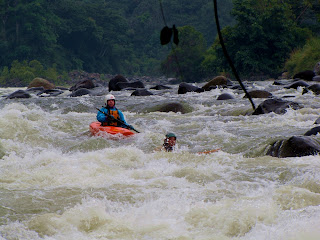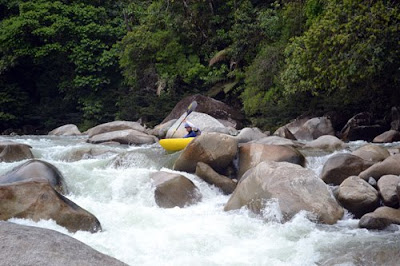Ruminahui--Indigenous defender of Ecuador--the beginning of the story of Orellana and Pizzaro.
(I love this shot of Stuart on the Oyacachi with the water captured as it's pouring out of his helmet and off his paddle--that's some serious immersion! Stuart was also digging the full immersion into the Ecuadorian Karaoke scene. He really brought some new energy into the Karaoke bar in Tena last week!)
So, on to what we are learning this week with SWA's blog...we always have to remember that before the "great European explorers" there were other people living in Ecuador. Before Humboldt, Orellana or Pizarro set foot in what is now called Ecuador, there were vibrant and varied Indigenous cultures.
(Mike working his way through the big granite boulders of the Rio Piatua. Mike was the grounding force to Stuart's antics, making sure we didn't permanently lose S-man to the bars of Tena)
Here I'm going to talk a little bit about the Incas near Quito whom Pizzaro defeated in order to stake his claim to this part of South America.
Due to superior technology and malicious intent (the Incas could have perhaps fought back better had they been anticipating a battle with these new comers) the Spanish overtook the Incas living in what is now Ecuador fairly quickly. Pizzaro was leading the Spanish through this region, and his success and advance was hardly slowed at all as he came through Northern Peru, up through modern-day Ecuador on his approach to Quito.
(Sam enjoying "quintessential" jungle scenery--complete with crystal clear water and blue skies--on the Upper Jondachi. Wait a second, does it say "Paddle Like a Girl" on your paddle?)
In 1532 Pizzaro's troops arranged a meeting with Atahualpa--the last independent leader of the Incan Empire. Atahualpa was born in what is now Cuzco, Peru and became the Incan Emperor after defeating his older half-brother--Huascar--in a civil war which ignited after their father died from a strange disease (historians today think it was probably Small Pox). Unfortunately for the Incas, Atahualpa walked peacefully into the trap Pizzaro had set for him, and upon his arrival, Atahualpa's guards were promptly killed and Atahualpa taken prisoner.
(Fran here enjoying a jungle waterfall on the Lower Quijos. Fran decided to warm up for her 3 week Water Color workshop with a week of kayaking with SWA!)
The Spainards held Atahualpa ransom for "a room filled with gold;" but when Ruminahui--an Inca Warrior who was very close to Atahualpa--brought them what they demanded, the Spanish didn't hold up their end of the bargain--damn those Spaniards were bastards!
(Spencer "rock, what rock?" Lincoln looking good in Disco-Tech on the Rio Piatua)
Instead of releasing Atahualpa, the Spanish put him through a trial (subjecting him to Spanish Crown law, not that of his own society), found him guilty of polygamy, worshiping false deities, and crimes against the king. Atahualpa was, consequently, sentenced to death; and the Spaniards were victorious in both getting their greed on (in the form of gold and silver) and of eliminating one of the last, powerful Inca leaders.
(Don, the group's fearless leader working his way through a boulder maze on the Piatua. Nice jungle behind him with the canopy closing in over the river--and the Piatua ain't no narrow river, there's just a lot of trees up there!)
(Brian--our resident meteorologist--following Tarquino through the rapids of El Chaco Canyon. Brian is trying to help us understand Amazonian weather patterns. After lots of fun and interesting conversations, I think we, and the world, are still confused about what exactly happens with the weather out here in the Amazon)
After Ruminahui brought the Spanish the gold and silver they demanded for Atahualpa's release, and after the Spanish broke their word and executed Atahualpa, Ruminahui is rumored to have ordered the "Treasure of Llanganatis" thrown into a lake so that the Spaniards wouldn't be able to steal anymore of the riches of the Inca Empire.
(Darcy, trying her best to be cool and throw the "brown," but failing miserably and blocking it with her paddle. Typical!)
In response to Ruminahui's defiance of Spanish power, Pizzaro ordered his troops to immediately take Quito; but anticipating this plan, Ruminahui had already ordered the city evacuated and burned to the ground. He figured if the Spanish were going to get the city, they should get a pile a rubble rather than a thriving cultural center.
(The gang on the bridge over the Oyacachi)
Finally, Ruminahui and Pizzaro's lieutenant Sebastian de Benalcazar met at the "Battle of Mount Chimborazo" and Ruminahui was defeated. But, he is still remembered today by his nick name "eye of stone" for his brave resistance to the Spanish. He is honored each year on December 1st in Ecuador.
(The Intern--aka Wes--enjoying his 11th day of paddling in row. I think that's a record for the Michigan boy)


































